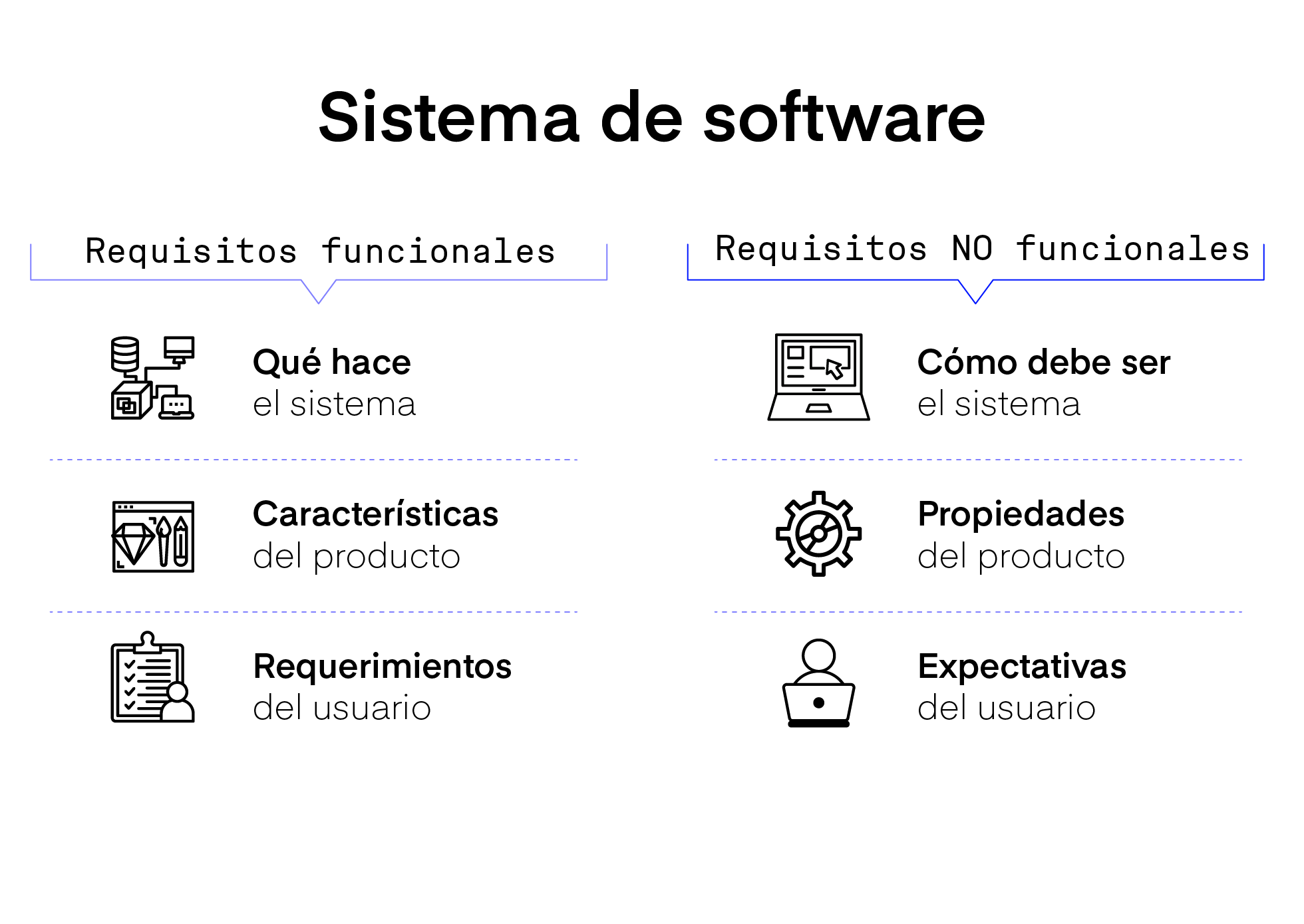Non-functional requirements: Why are they important?

A requirement is a statement that describes a feature, function, or restriction that a system or software must meet. These requirements can be of two types: functional, which describe what the system should do (for example, register a user), and non-functional, which describe how the system should be (for example, be secure or fast).
In the past, software and application development mainly focused on implementing the functionalities required by users, while usability, efficiency, performance, and security were not core priorities in design. This negatively impacted user satisfaction, business success, and the company's ability to adapt to changing technological and market demands.
With the implementation of non-functional requirements, these limitations have been addressed, leading to a more comprehensive and balanced approach in development. Now, these aspects are considered from the early stages of the development process, resulting in more robust, secure, and efficient applications and systems.
Non-functional requirements have contributed to business growth by laying a solid foundation for successful technological solutions. By meeting these requirements, your company can gain a competitive edge, enhance customer satisfaction, and build a strong base for long-term growth and success.
What are non-functional requirements?
Non-functional requirements, also known as "quality requirements" or "system attribute requirements," are features and criteria that describe how the performance, security, usability, and other aspects of a system or software should be, beyond its basic functionality.
Using non-functional requirements is an essential part of developing a system; it ensures that your software or application is effective, efficient, and meets the user's expectations and needs.
However, you should understand that these work hand in hand with functional requirements. What do we mean by this? You see, functional requirements focus on the 'what', while non-functional requirements concentrate on the 'how' and to what extent certain qualities are met. We'll explain this in detail below.

Non-functional Requirements vs. Functional Requirements
In software engineering, both functional and non-functional requirements play a crucial role in defining how a system is expected to operate and the qualities it should possess, such as usability, maintainability, scalability, and security.
Both types of requirements are essential to create a comprehensive and successful system. Let's look at how each one differs:
Functional Requirements | Non-Functional Requirements |
|---|---|
Describe what the system does. | Describe how the system should be. |
Detail the specific functionalities the system must provide. | Define the qualities, characteristics, and restrictions of the system. |
Focus on the functions and behavior of the system. | Focus on the quality, performance, security, and features of the system. |
Oriented towards what the system should achieve in terms of behavior and outcomes. | Oriented towards how the system should meet quality, performance, and experience requirements. |
Measured by their ability to fulfill specific scenarios and use cases. | Measured by attributes such as speed, security, usability, availability, among others. |
Directly affect the user's interaction with the system. | Indirectly affect the user experience and the quality of the system. |
Translate into specific functionalities of the system. | Translate into performance, security, usability criteria, among others. |
Types of Non-Functional Requirements
Non-functional requirements are the characteristics and properties of a system related to its performance, quality, and success. It is essential to adequately identify and define non-functional requirements to ensure the success and quality of the developed system. Here's a list of the most common ones:
Performance: Sets expectations for the system's speed and capacity. This can include aspects such as response times, loading times, performance under varying workloads, and scalability.
Security: Defines the necessary security mechanisms to protect the system and data from threats and attacks. This can include authentication, authorization, encryption, and protection against vulnerabilities.
Usability: Describes what the user experience should be like when interacting with the system. This can cover aspects such as the user interface, accessibility, ease of use, and user satisfaction.
Availability: Establishes how often the system should be available to users. This can encompass uptime objectives, planned downtime, and recovery from failures.
Reliability: Describes the system's reliability and its ability to operate correctly over a given period. This can include aspects like fault tolerance and error recovery.
Maintainability: Indicates how the system should be maintained and improved over time. This can entail ease of maintenance, documentation, and the ability to make changes without affecting stability.
Portability: Defines the system's ability to be transferred or adapted to different environments and platforms. This can include compatibility with various operating systems, browsers, or devices.
Scalability: Describes how the system can handle an increase in workload without degrading its performance. This can involve vertical scalability (improving resources of a single machine) or horizontal scalability (adding more resources or machines to maintain performance).
Examples of Non-Functional Requirements
Non-functional requirements will vary depending on the context and specific objectives of each system. Here are some examples by system type:
E-commerce System:
Performance: The system must load pages in an average time of less than 2 seconds.
Scalability: The system should be able to handle a 50% increase in traffic during the sales season without degrading performance.
Availability: The target availability rate should be 99.9%, so the system must be available 24 hours a day, 7 days a week, with a maximum downtime of 1 hour per month for scheduled maintenance.
Online Banking Application:
Security: Communication between the client and the server must be encrypted using the HTTPS protocol.
Usability: The interface must be accessible and usable by people with visual disabilities.
Maintainability: The source code must be well-documented and follow best programming practices to facilitate future updates.
Inventory Management System:
Efficiency: Inventory search and filter queries should complete in less than 1 second.
Stability: The system should be able to operate for at least 6 continuous months without requiring restarts due to failures.
Recovery Capability: In case of a server crash, the system should be able to recover and restore inventory data from the latest backup.
Social Network:
Interoperability: The system should be able to authenticate users through their Google, Facebook, and Twitter accounts.
Privacy: Users' personal data must be protected according to data protection regulations and will not be shared with third parties without the user's explicit consent.
Localization and Globalization: The user interface should be localizable for different languages and cultures and will display content relevant to the user's location.
Benefits of Non-Functional Requirements
Non-functional requirements offer numerous significant advantages in the development and deployment of software systems. Among their benefits are:
Mejora de la calidad del sistema. Se enfocan en cosas importantes como cuán rápido trabaja el programa, cuán seguro es y cuán fácil es de usar. Al tener estas reglas, te aseguras de que el programa sea de buena calidad.
Improved system quality. They focus on critical aspects like how fast the program runs, how secure it is, and how easy it is to use. By having these rules, you ensure the program is of high quality.
Enhanced user experience. They care about how people use the program. If a program is easy to understand and use, people will want to use it.
Performance optimization. They ensure the program doesn't become slow or freeze, even if many people are using it simultaneously.
Increased security. They help put "locks" on the program to prevent outsiders from accessing or stealing information.
Regulatory compliance. They ensure the program follows the rules, thus avoiding legal issues.
Easier maintainability. They make it simpler to fix and improve the program without causing problems.
Adaptation to different scenarios. They allow the program to adapt to different situations. Whether you want it in another language or on a phone instead of a computer, these requirements make it possible.
Effective planning and management. They help teams plan and manage resources properly to meet quality, performance, and security goals.
Competitiveness and reputation. They contribute to ensuring high-quality products and services meet market and customer expectations.
Prevention of future problems. By having these requirements from the start, you avoid issues that could arise later.
Non-Functional Requirements, a vital part in software development
Non-functional requirements are a crucial part of a software development project because they influence reliability, security, performance, scalability, adaptability, and stability. These components are fundamental to the system's success, directly affecting the quality and usability of the final product.
Furthermore, changes in non-functional requirements can have significant implications for the project, so they must be carefully established and controlled. Proper design and implementation of non-functional requirements are essential to ensuring success and meeting the needs and expectations of end-users.
Remember that they can directly affect the user experience and influence the resources needed to develop, implement, and maintain the software. Thus, we recommend considering them from the start of your project, leading to a more realistic and accurate planning.
In summary, including non-functional requirements in the development process ensures a comprehensive approach in creating successful systems. Ignoring these requirements can lead to severe software operational issues once implemented, which can be costly and challenging to address in later project stages. Are you already implementing them?


